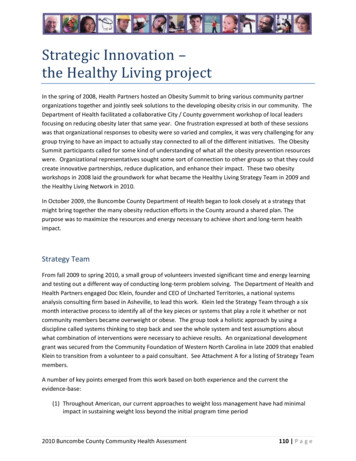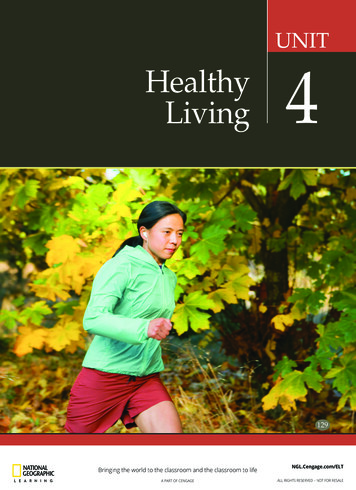
Transcription
Strategic Innovation –the Healthy Living projectIn the spring of 2008, Health Partners hosted an Obesity Summit to bring various community partnerorganizations together and jointly seek solutions to the developing obesity crisis in our community. TheDepartment of Health facilitated a collaborative City / County government workshop of local leadersfocusing on reducing obesity later that same year. One frustration expressed at both of these sessionswas that organizational responses to obesity were so varied and complex, it was very challenging for anygroup trying to have an impact to actually stay connected to all of the different initiatives. The ObesitySummit participants called for some kind of understanding of what all the obesity prevention resourceswere. Organizational representatives sought some sort of connection to other groups so that they couldcreate innovative partnerships, reduce duplication, and enhance their impact. These two obesityworkshops in 2008 laid the groundwork for what became the Healthy Living Strategy Team in 2009 andthe Healthy Living Network in 2010.In October 2009, the Buncombe County Department of Health began to look closely at a strategy thatmight bring together the many obesity reduction efforts in the County around a shared plan. Thepurpose was to maximize the resources and energy necessary to achieve short and long-term healthimpact.Strategy TeamFrom fall 2009 to spring 2010, a small group of volunteers invested significant time and energy learningand testing out a different way of conducting long-term problem solving. The Department of Health andHealth Partners engaged Doc Klein, founder and CEO of Uncharted Territories, a national systemsanalysis consulting firm based in Asheville, to lead this work. Klein led the Strategy Team through a sixmonth interactive process to identify all of the key pieces or systems that play a role it whether or notcommunity members became overweight or obese. The group took a holistic approach by using adiscipline called systems thinking to step back and see the whole system and test assumptions aboutwhat combination of interventions were necessary to achieve results. An organizational developmentgrant was secured from the Community Foundation of Western North Carolina in late 2009 that enabledKlein to transition from a volunteer to a paid consultant. See Attachment A for a listing of Strategy Teammembers.A number of key points emerged from this work based on both experience and the current theevidence-base:(1) Throughout American, our current approaches to weight loss management have had minimalimpact in sustaining weight loss beyond the initial program time period2010 Buncombe County Community Health Assessment110 P a g e
(2) The focus on relieving obesity as a problem often creates shame and self-loathing for thosewhom were labeled obese, thus minimizing the desired actions(3) All populations can benefit from the behaviors that promote healthy weights(4) Healthy weights are influenced directly by caloric balance, which focused on type and quantityof calories into the body (inputs), how calories were burned (outputs) and the physiology ofbody.(5) A wide range of drivers or root causes influence caloric balance, such as the cultural choicesaround food and physical activity, the built environment, food production and costs, the amountof physical activity in the workplace/school environments, life stage, etc.It should be noted that our surveillance system is not currently designed to measure all the things wefeel are important to measure, but it was critical to create the story that we wished to grow into versussimply measure the things that were easy to measure as our goals.The Healthy Living Strategy Team dedicated six months in 2009 and 2010 to understanding all of thepieces of Buncombe County life that impact a person’s opportunities to make healthy choices. TheStrategy Team turned away from the common tasks of identifying problems and looking for relativelyquick solutions. Instead, the Healthy Living project focused on using health systems analysis to reallyunderstand why people make the decisions they do about activity and food. Only after the team could”see the whole system” would the Network begin the strategic work of changing the context of ourcommunity so that more people would have health choices available and would be able to takeadvantage of those opportunities.Midway through the process, the group made an intentional decision to shift from organizing theirefforts to react to the problem (obesity) to focusing their attention on creating the good health theywere striving towards. In addition, based on input from wellness coaches and nutritionists, the StrategyTeam changed to a process that would strive to create a community where all residents could live ahealthy life – and not to simply focus on weight. The effort was re-named the Healthy Living project.These insights emerged from our systems thinking approaches and were eventually translated into amap that allowed our stakeholders to see the bigger picture before diving into action. In addition tohealthy weights, the map includes the outcomes of emotional and physical wellbeing, productivity, andbody-fat to muscle ratios. The map also includes a visual of all the key drivers or root causes thatinfluence the inputs and outputs of caloric balance and eventually the health outcomes. Many of thesedrivers already have various organizations engaged in finding solutions. The map is available on theDepartment of Health website at www.buncombecounty.org2010 Buncombe County Community Health Assessment111 P a g e
The Healthy Living NetworkOnce the Strategy Team had identified all of the key actors in the system that enable communitymembers to make healthy choices about being active and eating well, the Department of Health andHealth Partners sought to engage partners and community members in the longer-term work of makingsystem changes a reality. The Strategy Team conceived of creating a network that would serve to:Create new opportunities or expand existing ones so that residents could eat smart, move more,and live better.Connect partners and community members in creative ways to take action that improvesphysical activity and healthy eating.Keep us all connected to the “big picture” of how our various activities can collectively move ustoward a more healthy community.Break down silos that stifle innovation, keep us focused on our own turf, and lead to duplicationof efforts and services.Measure health and well-being outcomes for decades to come. Celebrate our successes andmake changes when needed.The Healthy Living Network is essentially an experiment in trying to create a healthy living movement byfocusing efforts in the community in a concerted way, while still allowing those who have diverseinterests to be involved.It is also clear that duplication of services sometimes creates a competitive atmosphere concerningfunding and resources. The Healthy Living Network will hopefully direct stakeholders to thinking deeplyabout what contributions are needed and foster a spirit of cooperation towards our desired healthgoals.Lastly, any new networks that emerge to address specific areas of need must coordinate their efforts inorder to succeed. The Healthy Living Network is a starting place for building Buncombe County’s publichealth capacity and tapping into the many diverse gifts and talents of its residents and organizations.The Healthy Living Network was launched at a Healthy Living Summit in April of 2010. Over 90participants spent the day learning about health systems analysis, coming to understand the map of theHealthy Living System that the Strategy Team had created, and identifying which piece of the systemeach of them wanted to focus on improving. The Summit was designed to harness the energyorganizational partners already had around addressing and improving different pieces of the system. Bythe end of the day, seven specific system issues had been identified and small group brainstorming hadbegun. Groups were charged with continuing to gather, defining what specific system changeinnovations they would promote, and beginning to align their work so that these innovations could beimplemented and succeed.2010 Buncombe County Community Health Assessment112 P a g e
Defining leverageThe key task of the Healthy Living Network is find ways to achieve systems changes that will enablemore Buncombe County residents to lead healthy, high-quality lives. It is NOT to create more programsand services. One key learning of health systems analysis is to identify and focus on leverage points.Points of leverage are those specific actions, policies, or experiments that offer an opportunity to createsystem changes that will have broad impact. One of the Healthy Living Network teams took on the taskof creating a set of criteria to define “leverage” in the Buncombe County Healthy Living context. Fivecriteria to use when considering which actions to be taken were identified. The criteria are:Is the action doable?What is the scope and scale of impact?Is it equitable?Is there ripeness of opportunity?Do local assets exist to make this action materialize?See Appendix D to review the Leverage Equation that all teams in the Network now use when selectinga specific system change to focus on. If the proposed action does not address each and every one ofthese questions, it will not be selected to move forward.Healthy Living Network TeamsSeven teams were created at the Healthy Living Summit in April 2010 to address causes or “drivers” ofhealthy living in Buncombe County. We are fortunate in Buncombe County to have many talentedindividuals and organizations working to address health and wellness. However, these efforts are oftenfragmented and duplication of effort is common. The goal of the Healthy Living Network is help makeconnections so that across the community, we can work smarter, reduce duplication of effort, identifykey partners and better address critical gaps.To date, the seven teams created the day of the Healthy Living Summit have had varying levels ofsuccess. A key lesson learned is that fostering the work and impact of the teams requires on-goingstaffing and cultivation.The Physical Activity TeamThe Healthy Living Network Physical Activity Team was formed to develop a strategy to increase physicalactivity in Buncombe County. The team has chosen to do this by creating a communication andencouragement strategy that will roll out in one neighborhood as a pilot project in 2011. Key goals are:To increase the awareness in communities of the many existing parks, open spaces andgreenways nearby for physical activity andTo provide support to engage community members and encourage them to use these spaces.Initially, a single neighborhood or area will be identified and will receive focused attention. We thenhope this approach can be replicated across the county in both rural and urban areas.The Opportunities for Physical Activity – Built Environment TeamThe Healthy Living Network Built Environment Team was formed to develop a strategy to createopportunities for physical activity through policy and environmental change strategies. Streets designed2010 Buncombe County Community Health Assessment113 P a g e
solely for the automobile deny people the opportunity to choose more active ways to get around, suchas walking and biking. Complete streets policies ensure that transportation planners and engineersconsider all users in transportation design - including bicyclists, pedestrians of all ages and abilities aswell as public transportation users. This team has chosen to address this by providing support toBuncombe County municipalities to enact Complete Streets Policies.Access to Whole, Healthy Foods TeamThis team was created to develop a strategy to improve community-wide nutrition by increasing accessto whole, healthy foods. The team was challenged with multiple scheduling issues after the AprilSummit. Several strategies are currently being explored with individual organizations and we anticipateforming a team in early 2011.Nutrition TeamThis team was created to develop a strategy that would encourage Buncombe County residents toconsider altering the way they eat and to include more fresh, whole foods in their diet. To date, teammembers have been exploring strategies for supporting gardening as an activity that allows communitymembers to grown their own healthy food.Health Systems TeamThis team was formed to develop a strategy that would promote a systemic integration ofencouragement of physical activity and good nutrition into clinical medical encounters. A number ofhealth care providers have joined the team and team members are focusing on developing strategiesthat will:1. Ensure that local child and adult focused medical practices include age-appropriate Body MassIndex calculations as a part of clinical visits, and2. That health care providers actually consider the BMI when making recommendations to thepatient.Social and Economic Factors TeamAfter creating the leverage equation, members of this team have been unable to devote the time tocontinue their efforts.Personal Motivation TeamThis team was designed to focus on creating a strategy to offer standard best-practices concerning howto motivate and support community members, clients and patients to adopt health lifestyle behaviors.Due to scheduling challenges, this team is not far along in its deliberations.Network DirectoryA clear need emerged in the development of the Healthy Living Network to create a mechanism thatwould foster partnerships, enable community organizations to work together more efficiently, and toprevent duplication. The Healthy Living Network Directory being created will be an on-line tool that willaddress this need. It is important to note that this is not a directory of services, but a tool to enhancenetworking and strategic partnerships. The Directory is currently under development with ananticipated launch date in early 2011. This user-friendly electronic directory will be housed on theBuncombe County Department of Health website.2010 Buncombe County Community Health Assessment114 P a g e
Data collection for the directory began with the Healthy Living Summit in April 2010 and has beenpromoted and circulated to organizations throughout the county. Currently, 74 organizations havecreated network profiles to be included in the directory. Organizations, volunteer groups, andinstitutions are able to create a profile and identify which of the topics and key words below relate toissues they are already working to address and/or would like to create new partnerships around.The Directory will include the following focus areas with related key word search capability that willenable identification of more detailed information on the practice or service areas each organizations’addresses:Nutrition / healthy food. Keywords: Cost of Food, Amount of Food, Quality/Safety of Food,Food Production/Distribution, Healthy Eating Experience, Knowledge, and SkillsOpportunities to be physically active. Keywords: Amount of Leisure Time, Access toSafe/Quality Places to Exercise, Parks and Green Spaces, Workplace Activity, Physical ActivityExperience, Knowledge, and SkillsIndividual behavior. Keywords: Mindsets, Goal Setting/Assessment, Cultural Traditions,Stress/Sleep, Mental Health, Independent Living SkillsHealth systems. Keywords: Outpatient Education and Support, Health Promotion, Health Careand Prevention Capacity, Access and Coordination of Care, Costs and Quality of CareCommunity context / social and economic factors. Keywords: Graduation Levels, EducationalAttainment, Built Environment, Family/Community Support, Housing, Livable Wage, IncomeStability, Equal Opportunity, NetworksOrganizations also use their profile to further clarify the types of activities they are engaged in including:Education of individualsCommunity education and/or organizingDirect advocacy with leadersTeaching / coordinating advocacy efforts among community members/ clientsPolicy developmentAssistance to organizationsAssistance to familiesAssistance to individualsStrategic partnership developmentClinical servicesWhen the Healthy Living Network Directory is created, it will be a tool that organizations as well asindividual community members will be able to use to seek out new partners or organizations withsimilar interests. The Directory will allow a wide variety of groups and organizations to easily connectwith each other and will bypass the current need for knowledgeable people to connect those theyhappen to know about who might like to try working together.2010 Buncombe County Community Health Assessment115 P a g e
Healthy living opportunities web mapThough Buncombe County and its communities offer a wealth of opportunities to be active and to eatwell, few residents or organizations are aware of all the supports for healthy living that already exist.The Department of Health and Health Partners brought together a team of GIS experts and healthvolunteers to create an on-line map application that could be used to connect residents withopportunities for being physically active and eating well. This team met for nine-months to create aprototype of the Buncombe County Healthy Living Opportunities Map.The Map team brought together GIS experts, medical professionals, neighborhood advocates, andcommunity volunteers. Together, this diverse group created an inventory of local resources that couldbe co-located in one web application. The map will be launched to the community in early 2011.Current resources available on the map are:SidewalksCounty and City Parks and all of the amenities in each park (so a resident can search only bytennis counts, or example or only by basketball courts)Greenways and trail networksBike routesFull Service grocery stores and discount stores – provided through a research project of the UNCAsheville Department of Health and Wellness. Students and interns surveyed over 50 localgrocery stores using the Nutritional Environments Monitoring Survey, a tool available from theCenters for Disease Control and Prevention. The survey instrument provides a score for grocerystores based on the fruits and vegetables they have available and also assesses the availability oflow fat or healthier options to common items such as milk, hot dogs, soda, and bread.Farmers markers and tailgate marketsBus routes and Mountain Mobility routesAdditional layers to be added include:Food bank food distribution sitesCommunity GardensIf volunteer labor can be identified, UNC Asheville is interested in implementing theConvenience Store version of the Nutritional Environments Monitoring Survey in 2011 or 2012.A training session will be developed and offered to local medical practices, non-profit organization, andemployers so they can engage their patients, clients and employees in using the map to link to localresources for being active and eating well.2010 Buncombe County Community Health Assessment116 P a g e
The Healthy Living Network was launched at a Healthy Living Summit in April of 2010. Over 90 participants spent the day learning about health systems analysis, coming to understand the map of the Healthy Living System that the Strategy Team had created, and identifying which piece










